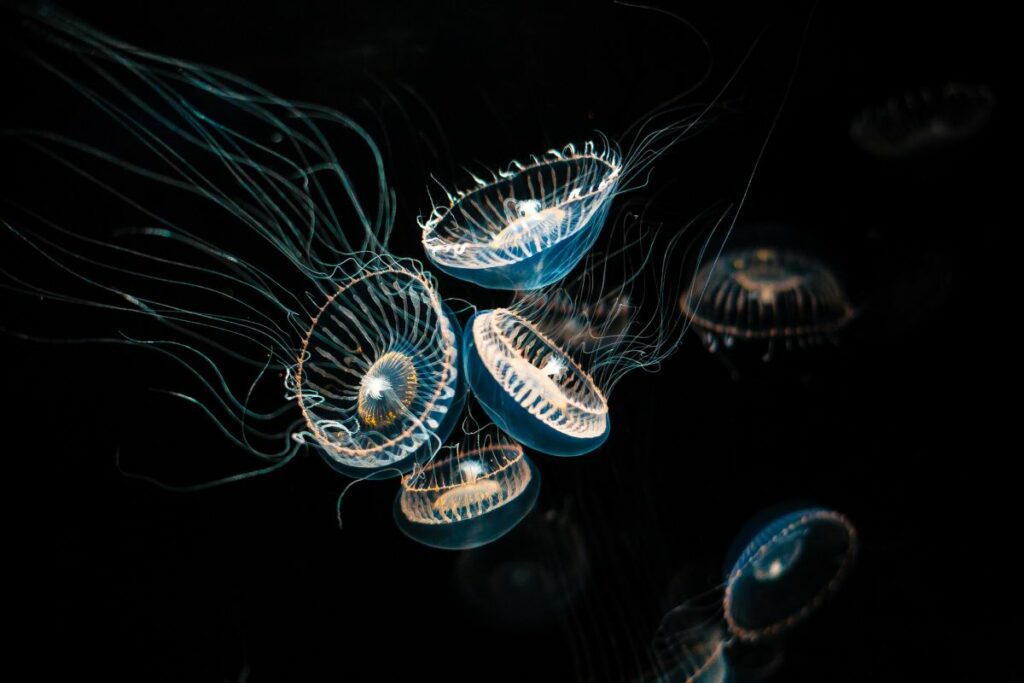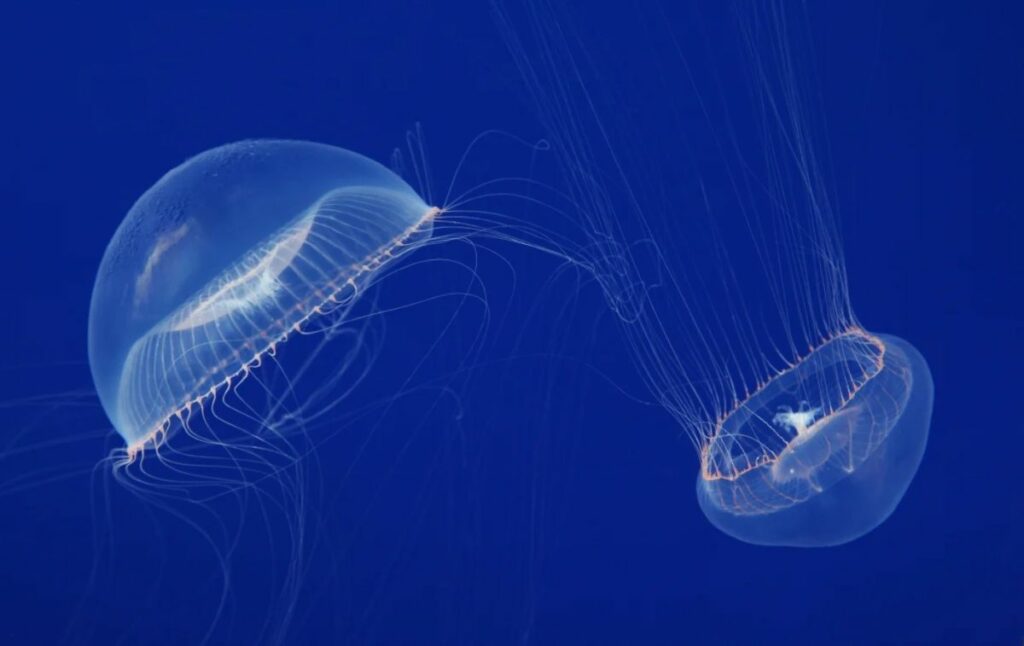The crystal jellyfish is a small, transparent jellyfish prized for its bioluminescent abilities. Many jellyfish are bioluminescent, but the crystal jellyfish has over 100 mini-organs that produce light. In time, researchers believe they can use the properties of these light-bearing organs to progress in science.

What Is A Crystal Jellyfish?
Crystal jellies are nearly transparent with long tentacles.
Crystal jellyfish are bioluminescent and emit a blue-green glow when they feel threatened. They have over 100 tiny organs surrounding their bell that produce light.
The Cabrillo Marine Aquarium describes this ability:
“At times, the crystal jelly can give off a green glow around the edge of the bell. This is caused by a photoprotein, called aequorin, which emits blue light (called bioluminescence), and an accessory protein, called the green fluorescent protein (GFP), which emits green light. GFP accepts energy from aequorin and re-emits it (called fluorescence) as green light.”
Researchers collect crystal jellyfish for their excellent bioluminescent capacity. They use the luminescent aequorin, a bioluminescent protein, to detect calcium in biological and neurological experiments.
In captivity, aquarists have kept crystal jellyfish alive for over two years. But, it’s uncommon that they live over six months in the wild.
- Common Names: Crystal Jellyfish
- Scientific Name: Aequorea victoria
- Origin: Southern California to Vancouver, Canada
- Size (Diameter): Up to 10 in (25.4 cm)
- Crystal Jellyfish Life Expectancy: 6 months to 2 years
Habitat
A crystal jelly usually lives off the Pacific coast of North America from southern California to Vancouver, Canada. You are most likely to see them in these waters from spring to autumn.
Diet

Aequorea jellies often eat other jellies up to half their size, expanding their mouth to accommodate the large prey. They seem to prefer comb jellies and other hydromedusae. They also eat other jelly-like animals such as ctenophores, polychaetes, and appendicularians. Sometimes, they eat copepods.
Keepers at aquariums must be cautious of overcrowding because crystal jellies will cannibalize one another.
Reproduction
All jellyfish reproduce both sexually and asexually. They reproduce asexually as polyps, creating genetically identical clones of themselves.
As adults, jellyfish reproduce sexually, creating sperm or eggs. Hermaphrodites are rare in jellyfish, so most animals will be either male or female. They release the sperm and eggs into the water column. When the sperm and eggs touch, the eggs fertilize, and jellyfish larva eventually hatch.
Predators
Aequorea jellyfish are not the largest jellies, so they are susceptible to a host of predators, despite their stinging tentacles. Larger jellies, like the lion’s mane jellyfish, are their most common predators.
Conclusion
The Aequorea victoria jellyfish is a transparent jellyfish with over 100 bioluminescent organs. They live off the coasts of the Pacific Ocean, from southern California to Vancouver, Canada. They also have large, expandable mouths that they use to eat other jellyfish nearly half their size.
FAQs
Crystal jellies are cnidarians, meaning they have stinging cells in their tentacles. As their tentacles brush against something, it causes their cnidocytes, or explosive cells, to fire. Nematocysts come from cnidocytes. Nematocysts are barbs that lodge into the skin and release toxins.
Like all jellies, crystal jellyfish will sting and release their toxins if you touch them. But, compared to most jellies, a crystal jellyfish’s sting is mild. It doesn’t cause any lasting harm, and many people don’t even realize it has stung them.
About 95% of a jellyfish comprises water, making these animals simple creatures. The rest of their body comprises three layers. The outer layer is the epidermis, and the outer layer is the gastrodermis. Between those two layers is the mesoglea, a thick, gelatinous-like substance that gives jellyfish their jelly-like appearance.
About 50% of jellyfish species are bioluminescent, meaning they can glow. Crystal jellyfish, in particular, exhibit exceptional bioluminescent abilities. They have over 100 miniature organs that produce light. The light that crystal jellies produce is so valuable that researchers often harvest them for study.
The International Union for the Conservation of Nature (IUCN) has not assessed crystal jellyfish populations. There is no current research to suggest crystal jellyfish are endangered.
Researchers realize how important jellies are to our understanding of the world and the way it’s changing.
The Monterey Bay Aquarium says:
“Jellies can be very sensitive to water quality during certain points in their life cycles. Changes in the health of jelly populations may be a tip-off to larger environmental problems. Recent jellyfish “blooms,” for example, are being studied for their potential as sentinels of ocean change.”
Jellyfish are also vital prey for other ocean animals like ocean sunfish and sea turtles. Unfortunately, our use of plastic bags is killing these predators. They mistake plastic bags in the ocean as jellyfish, often suffocating.
